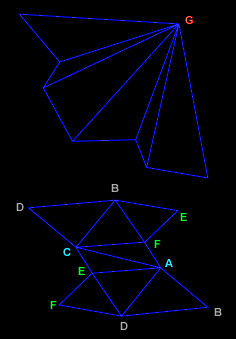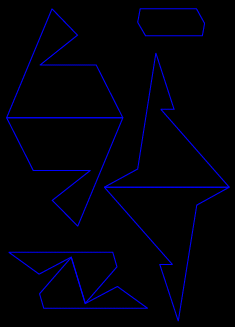the Császár and Szilassi polyhedra
Does there exist polyhedra without diagonals? The vertices being joined two by two by an edge, all their faces are triangular.
The most simple of all polyhedra, the tetrahedron, is an example, and it is the only one without holes of this type.
The Euler formula generalized to the polyhedra with h holes: f+v-e=2(1-h) gives (v-3)(v-4)=12h whose solutions are:
h=0 and v=4: the tetrahedron!
h=1 and v=7: this polyhedron has been described in 1940 by Akos Császár
h=6 and v=12, h=11 and v=15 . . . but nobody has not yet described one of these polyhedra!
The Császár polyhedron is not easy to "see"; one must first visualize the seven vertices in the space. The first six are the ends of three segments AC, BD and EF situated in three parallel plans, with AC "between" the two others; they build a "base" of eight triangles. The sevens vertex G is common to the six other faces: they build a "cap" which covers the "base".
|
 |
Seen from the top, ABDC appears like a square with center G.
LiveGraphics3D allows you to see well how the seven vertices are situated in the space.
To build your own model you may download and print the net (PDF file).
LiveGraphics3D has difficulties to display well the faces, but showing the faces progressively, one after the other, allows you to see how the toroidal "base" (with one hole) is built; it will later be partially hidden by the "cap".
|
|
Császár polyhedron
Szilassi polyhedron |
14 triangular faces
7 hexagonal faces |
7 vertices of order 6
14 vertices of order 3 |
1 tunnel
1 tunnel |
21 edges
21 edges |
The topological dual of the Császár polyhedron has been described in 1977 by Lajos Szilassi; its seven hexagonal faces are two by two adjacent. Its net (PDF file) may also be downloaded.
Remark: The four-color theorem - the first major theorem to be proved using a computer - states that any "map" drawn in a plane or on a sphere can be well colored using four colors ("countries" sharing a common boundary are not allowed to have the same color). On a torus seven colors are required; Szilassi's toroid needs indeed seven colors so that two adjacent faces have different colors.


